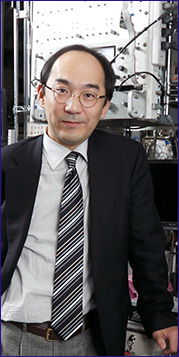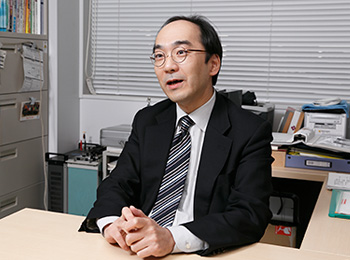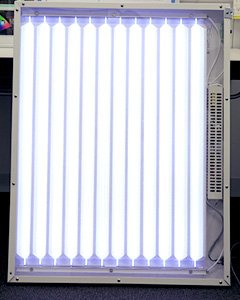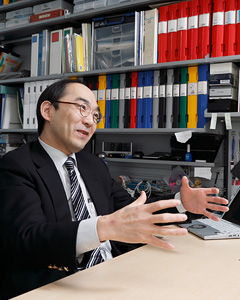

Artificial light is an essential element of plant factories
I specialize in optical properties and devices, electronic materials and similar fields. With a central focus on electronic devices utilizing optically functional thin films, I have spent my recent years involved in the development of flat-panel display materials and devices using electroluminescent elements as well as in research on thin film light-electric conversion components for use in light sources for illumination, solar battery, etc.As a member of the current plant factory project, I am in charge of artificial lighting research and development, which is a major factor in achieving more widespread diffusion of plant factories.
Plant factories are expected to develop and spread as cultivation facilities for the next generation of farmers. However, electricity costs incurred in fully enclosed plant factories utilizing only artificial light sources are reflected back in agricultural produce prices. Even though vegetables grown in plant factories are generally expensive, they offer added value when compared with standard vegetables grown outdoors, including pesticide-free growing, high nutritional content, excellent texture, etc. The real question is how to lower costs related to light sources in order to take advantage of this added value—our primary challenge is to develop light sources that use less electricity and last for longer periods of time in order to cut production costs, lower unit prices and reduce running costs.
Utilization of existing light source technologies

Associate Professor Miura’s interests are centered primarily on the field of manufacturing, which he considers to be the lifeline of Japan
Cold-cathode fluorescent lamps (CCFLs) are utilized in currently operating plant factories: these were originally developed for use as backlights in liquid-crystal displays (LCDs) in particular as well as in other thin display equipment. Compared with incandescent bulbs, these light sources give off far less thermal radiation, making them well-suited for maintaining suitable temperatures during plant cultivation. The combination of minimal heat generation and the ability to place the light source closer to the plants enables ample amounts of light to be provided for growing. This approach offers other significant advantages as well, including facility size reduction or else the placement of additional cultivation shelves in existing spaces.

Most plant factories today use cold-cathode fluorescent lamps (CCFLs)
In search of ideal light sources for plant growth
Determining precisely how much light is optimal for effective plant growth is one way to increase efficiency. Furthermore, plants utilize photosynthesis to absorb carbon dioxide and release oxygen, and because they do not require light when releasing oxygen, it may be possible to, for example, control intermittent light emissions for the plants based on shorter time domain intervals in order to conserve energy while also promoting plant growth.It is important to keep in mind that CCFLs and LEDs were originally design as light sources and not for the purpose of promoting plant growth. If these technologies are able to provide sufficient amounts of light for plant factory use while also achieving low-energy operations, these advances will surely have an impact on lighting used in households, offices and elsewhere. As a researcher, I want to start from basic ideas to create new technologies rather than applying existing technologies.
Addressing environmental and food problems

Today, many people have all that they need, and there are very few things that they truly want. Rather than mindlessly pursuing needs in a world such as this, I feel it is more important to think hard about how to enrich people’s lives and make them feel happier. It seems that the best way to serve society through production is to consider what is needed for the future, and based on this idea, I feel that the practical application of plant factories is truly important.
Bringing together knowledge from various academic disciplines
It goes without saying that solving the problems we face today is no easy task. It may take another century before we achieve ultra-energy-efficiency as described above, and there are some obstacles we may never be able to overcome. But simply deciding that something is impossible from the outset ensures that no progress will be made. At the Meiji University Advanced Plant Factory Research Center, we operate based on the guiding concepts of increasing plant factory production efficiency and lowering production costs. Through collaborative efforts between different academic disciplines such as agriculture and engineering toward the development of a cultivation system that uses energy with great efficiency, I believe that we will be able to uncover brand new approaches.Moving forward, we will systematically evaluate and analyze factors such as leaf thicknesses and its optical properties, properties derived from morphological observation via electron microscopes and flavors in order to shed more light on the mechanisms of plant cultivation and develop light sources that enable the cultivation of more delicious vegetables that cost less and grow more quickly. We must also explore ways to provide light that is more suited to plant cultivation by looking at light properties, how light is directed, the necessity of colors other than blue and red, weak and strong densities, etc.
As part of efforts to increase efficiency, I believe it is important to take note of light that is wastefully directed toward walls rather than being absorbed by plants, consider recycling heat that is emitted from light sources, and take other such factors into consideration.
Profile
Associate Professor, Department of Electronics and Bioinformatics, School of Science and TechnologyAfter serving as a full-time lecturer in the Meiji University School of Science and Technology, Noboru Miura became an associate professor in 2007. He has a Ph.D. in engineering from Meiji University.
Light emitters and displays, functional devices and materials, electronics
Hakko to Juko no Butsuri to Oyo (“Physics and Applications of Light Emission and Reception,” joint authorship, Baifukan), Denshi Disupurei no Subete (“All About Electronic Displays,” joint authorship, Kogyo Chosakai Publishing), others









